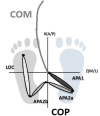A biomechanical study of gait initiation in Down syndrome
- PMID: 30987596
- PMCID: PMC6466789
- DOI: 10.1186/s12883-019-1288-4
A biomechanical study of gait initiation in Down syndrome
Abstract
Background: Gait Initiation (GI) is a functional task that challenges the balance control requiring weight shift and a transition from standing to walking. Individuals with Down Syndrome (DS) walk with low velocity, prolonged stance and shorter steps beside an increased support base. However, no studies performed GI analysis on this population. The aim of this study is to quantitatively characterize the GI task in subjects with DS compared with a typically developed control group.
Methods: Seventeen individuals with DS (17 to 40 years) and 19 healthy subjects (17 to 40 years) were enrolled in the study. Data were acquired using an optoelectronic motion capture system and force plates in order to measure the displacement and velocity of Center of Mass (CoM) and the trajectory of Center Of Pressure (CoP). All participants were asked to stand barefoot on the first force platform and received a verbal cue to begin walking for 6 gait initiation trials (three starting with each foot). The CoP duration, velocity, length and excursion were calculated during the anticipatory postural adjustments phases (APAs) and the locomotor (LOC) phase. For the analysis of the CoM, its displacements in antero-posterior (AP) and medio-lateral (ML) during the APAs and LOC phases. Statistical analysis was conducted to compare the two groups.
Results: Regarding CoP measures, when compared to control group, individuals with DS presented higher durations, lower velocities, longer lengths during the second APA and total phases, and shorter lengths during the first APA and LOC phases. The group with DS also presented longer CoP excursion during the second APA, whereas a shorter excursion was present during the first APA and LOC phases. The AP excursion in CoM is reduced in the participants with DS.
Conclusions: Our results could be useful in the rehabilitation of individuals with DS as they suggest to reinforce exercise programs to improve balance in AP and ML directions, which is demonstrated to be impaired in these subjects.
Keywords: Biomechanics; Down syndrome; Gait initiation.
Conflict of interest statement
Ethics approval and consent to participate
All procedures performed in studies involving human participants were in accordance with the ethical standards of the institutional and national research committee and with the 1964 Helsinki declaration and its later amendments or comparable ethical standards. The study was approved by the IRCCS San Raffaele Pisana Ethics Committee, Roma (Italy) (Protocol identification number: SPOL – 17/17 – 6/2017). All participants were volunteers and gave written informed consent which was confirmed by parents if necessary.
Consent for publication
Not applicable.
Competing interests
The authors declare that they have no competing interests. All authors declare no conflicts of interest and any financial interest. All authors attest and affirm that the material within has not been and will not be submitted for publication elsewhere.
Publisher’s Note
Springer Nature remains neutral with regard to jurisdictional claims in published maps and institutional affiliations.
Figures

 = Origin,
= Origin,  = 1st min;
= 1st min;  =1st max
=1st max  = 2nd min
= 2nd min  = End
= End

References
-
- Aruin AS, Almeida GL, Latash ML. Organization of a simple two-joint synergy in individuals with Down syndrome. Am J Ment Retard. 1996;101:256–268. - PubMed

